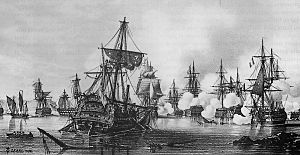HMS Hannibal (1786) facts for kids

HMS Hannibal (left foreground) lies aground and dismasted at the First Battle of Algeciras.
|
|
Quick facts for kids History |
|
|---|---|
| Name | HMS Hannibal |
| Ordered | 19 June 1782 |
| Builder | Perry, Blackwall Yard |
| Laid down | April 1783 |
| Launched | 15 April 1786 |
| Honours and awards |
Participated in: First Battle of Algeciras |
| Captured | 6 July 1801 by the French at the First Battle of Algeciras |
| Name | Annibal |
| Acquired | 6 July 1801 |
| Fate | Broken up 1824 |
| General characteristics | |
| Class and type | Culloden-class ship of the line |
| Tons burthen | 161957⁄94 (bm) |
| Length | 170 ft (51.8 m) (gundeck) |
| Beam | 47 ft 6+3⁄4 in (14.5 m) |
| Depth of hold | 20 ft 0 in (6.1 m) |
| Propulsion | Sails |
| Sail plan | Full-rigged ship |
| Armament |
|
HMS Hannibal was a powerful warship of the Royal Navy. She was a 74-gun third-rate ship of the line, launched on April 15, 1786. Her name came from Hannibal, a famous general from Ancient Carthage.
This ship is most famous for her role in the Algeciras Campaign. During the First Battle of Algeciras on July 5, 1801, she got stuck. This led to her capture by the French. After that, she served in the French Navy until she was taken apart in 1824.
Contents
Early Adventures of Hannibal
Hannibal began her service in August 1787. Her first captain was Roger Boger. In May 1790, Captain John Colpoys took command.
Later, in August 1791, she became a guardship at Plymouth. Guardships protected important naval ports. As war with France seemed likely in late 1792, Hannibal and other guardships gathered at Spithead.
Chasing French Ships
In February 1793, Hannibal and another ship, HMS Hector, went on a patrol. They chased two French frigates and captured a French merchant ship called Etoille du Matin.
After returning, Hannibal got ready for duty in the West Indies. She sailed with a fleet in March 1793. She came back to Britain in early 1794 for repairs.
Battles and Captures
Captain John Markham took command in August 1794. In April 1795, Hannibal was part of a group of British ships. They chased three French frigates.
Another British ship, HMS Astraea, captured the French frigate Gloire. The next day, Hannibal captured the 32-gun French frigate French frigate Gentille. The Royal Navy later used Gentille as one of their own ships.
Hannibal also helped capture other ships. She shared in the prize money for recapturing the Caldicot Castle. She also helped capture a French privateer (a privately owned warship) called Jean Bart. The Navy later used Jean Bart as Arab.
West Indies Duty
In May 1795, Hannibal sailed to Jamaica in the West Indies. While there, she captured several French privateer ships. These included the schooner Grand Voltigeur and the ships Convention and Petit Tonnerre.
Captain Markham left Hannibal in December 1795. Other captains, like T. Lewis and Robert Campbell, commanded her in the following years. Captain John Loring was her captain in 1800 before she was taken out of service for a short time.
The Battle of Algeciras and Capture
Captain Solomon Ferris took command of Hannibal in March 1801. She sailed from Spithead in June 1801 to join Rear-Admiral Sir James Saumarez in the Mediterranean Sea.
The First Battle
On July 6, 1801, Saumarez's ships attacked a French squadron in Algeciras Bay. Hannibal was the last British ship to arrive. She anchored and fired her guns for about an hour.
Admiral Saumarez then ordered Hannibal to move closer to support another British ship, HMS Pompee. But as Hannibal moved, strong winds pushed her into shallow water. She got stuck on the seabed.
Even though she was stuck, Captain Ferris kept firing at the French flagship, Formidable. He also fired at the town and enemy gunboats. Other British ships tried to help Hannibal, but it was too dangerous.
A Difficult Decision
Around 1:30 PM, the British ships pulled back to Gibraltar. Hannibal was left stuck and alone. Captain Ferris talked with his officers. They decided it was useless to fight more. To save their crew, they had to surrender.
Hannibals firing had almost stopped. Ferris ordered his men to go below deck for safety. He then signaled surrender by raising Hannibals flag upside down. The battle had been costly for Hannibal, with 75 men killed and 62 wounded.
The French and Spanish could not fix Hannibal quickly. So, she could not join them in the next battle, the Second Battle of Algeciras, where they were defeated. Captain Ferris and his crew were later cleared of any blame for losing their ship.
The French renamed Hannibal to Annibal. In November 1801, she was seen near Brest under French colors. She was sailing with temporary masts.
Later, in February 1802, Annibal sailed from Cadiz to Toulon. There, she underwent major repairs and updates. She continued to serve in the French Navy until 1821. She had another refit in Toulon in 1809.
In 1806, some of her guns were changed. She had fewer large guns but gained more powerful, shorter-range guns called carronades. In May 1807, the British frigate HMS Spartan saw Annibal and other French ships near Cabrera. But Spartan managed to escape.
End of the Ship
In January 1821, Annibal became a hulk at Toulon. A hulk is an old ship that is no longer used for sailing but serves as a floating storage or barracks. She was finally taken apart in 1824.
See also
- List of ships captured in the 19th century

